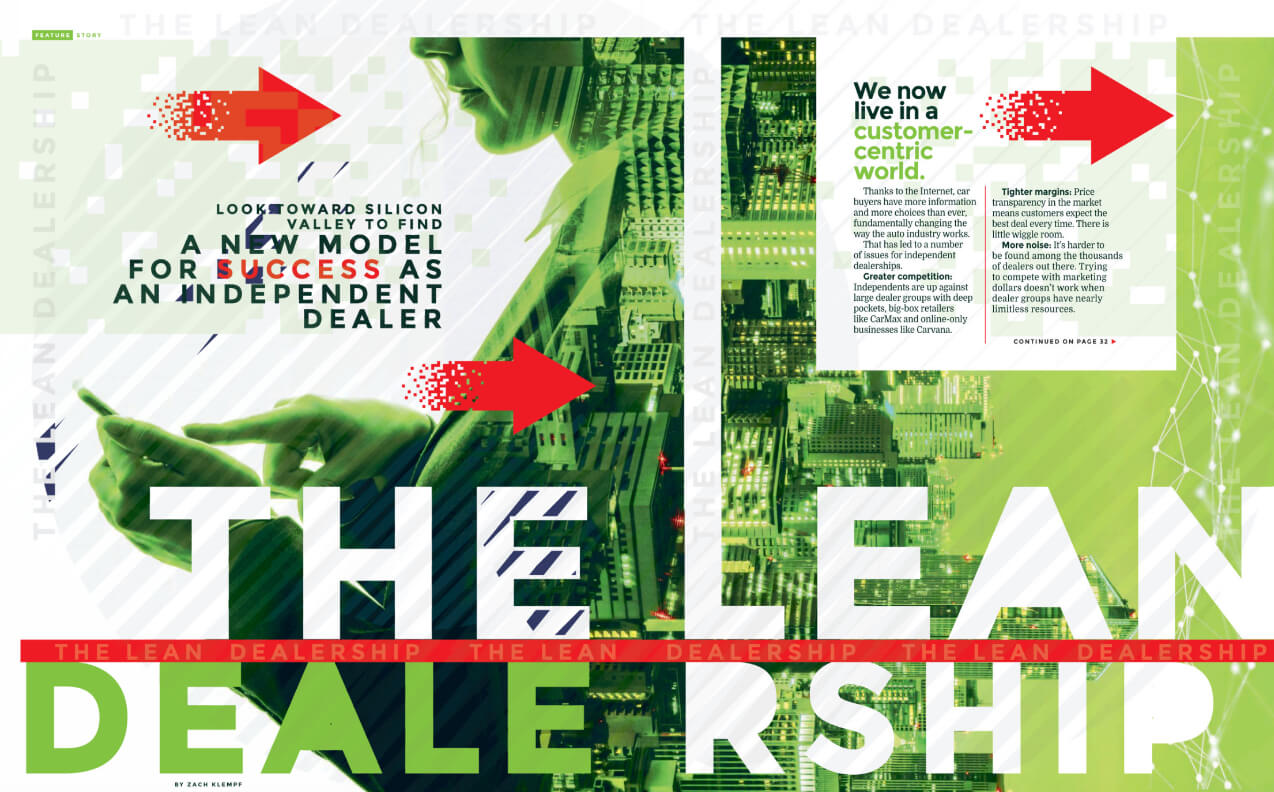We now live in a customer-centric world. Thanks to the internet, car-buyers have more information and more choices than ever, fundamentally changing the way the auto industry works. This has led to:
● Greater competition. Independent dealers are up against large dealer groups, big-box retailers like CarMax, and online-only businesses like Carvana.
● Tighter margins. Price transparency in the market means customers expect the best deal every time. There is little wiggle room to improve your margin.
● More noise. It’s harder to be found amongst the thousands of dealers in the industry. Trying to compete with marketing dollars doesn’t work when dealer groups have near limitless resources.
Franchise dealerships are being bought up by large dealer groups at a record rate. That means independent are facing stronger competition with deeper pockets. To thrive in today’s industry, independent dealers need to change the way they do business.
A New Way to Do Business
Large dealers get away with bloat and inefficiencies because they have the money to do so. Small and mid-sized dealers can’t afford to be inefficient. This is actually a blessing in disguise.
Independent dealers need to learn how to do more with less. Fortunately, a new model for doing business already exists, but it doesn’t come from the automotive world. For insight, we need to turn to Silicon Valley.
Running Dealerships Like Tech Startups
Silicon Valley companies have transformed the way they do business thanks to The Lean Startup, a New York Times best-selling business book by author and consultant, Eric Ries.
In his book, Ries outlines a new strategy for building successful businesses, one that promotes continuous learning while minimizing waste. Going lean, Ries argues, is the key to competing in highly competitive markets.
Even though The Lean Startup was written with tech companies in mind, its principles are universal. We can take what The Lean Startup teaches us and apply it to independent dealers.
We call this methodology, The Lean Dealership.
The Lean Dealership
The Lean Dealership takes the old way of doing business and flips it on its head. That means:
1. Work smarter, not harder. No amount of effort from an independent dealer can match the resources of a Carvana or large dealer group. Fighting fire with fire is a losing battle. Independent dealers need to use data and experimentation to work smarter, not harder, to beat the competition.
2. Measure what matters. We need to use metrics that steer us toward success, not what looks good on paper. Turn rate, for example, is much more indicative of our dealership’s success than total units sold.
3. Eliminate uncertainty. Most independent dealers take a throw-mud-against-the-wall-and-see-what-sticks approach to marketing. That will no longer cut it. Dealers need a systematic way to build and grow their dealerships.
Borrowing tactics and strategies from The Lean Startup, we have created a methodology that will help independent dealers buck conventional trends and find success in today’s highly competitive market.
Does the Lean Startup Apply to Independent Dealers?
The word “startup” evokes images of fast-growing tech companies like Airbnb and Uber. In the automotive industry, we might use startup to describe online-only retailers like Carvana or TrueCar (even though both companies are now publicly traded).
Believe it or not, independent dealers are not that different from technology companies when it comes to building a profitable business.
The Lean Startup defines a startup as: "Any human institution designed to create a new product or service under conditions of extreme uncertainty."
I argue that this applies to independent dealerships as much as tech companies. Are dealerships not human institutions who create (and sell) services and products? Is there not extreme uncertainty in the industry, especially for independent dealers?
Tech companies are experts at disrupting highly competitive industries like hotels and taxis. Independent auto dealers face fierce competition as well, which is exactly why we should learn from the Silicon Valley playbook.
The Lean Dealership methodology can help dealers make smart decisions in the most trying of times.
The Lean Dealership Methodology
There are 3 Parts to the Lean Dealership model:
1. What Makes You Different?
2. Build, Measure, Learn
3. Systemize and Automate
We will go through each part and share examples of how they can be applied to your dealership. If you are ready for your independent dealership to thrive, then let’s dive in.
Part 1: What Makes You Different?
The key to succeeding in any industry is solving an unmet need in the market. This has gotten more difficult for independent auto dealers in recent years. There are more dealerships than ever, plus larger companies that can operate off less margin.
However, independent dealers still have an advantage over online startups and large dealer groups: They are closer to the customer.
Independent dealers have deeper roots in their community, which means they are closer to the problems their customers face. Focusing on the customer is how independent dealers win.
Understand Your Customers: Go See for Yourself
Customers aren’t just going to tell you what they want (and often, they don’t know what they really want). Instead, dealers need to find out for themselves.
The Lean Startup introduces a Japanese concept called Genchi Gembutsu, which roughly translates to “Go see for yourself.” Genchi Gembutsu means you should develop a first-hand account of your customer’s wants and needs.
There’s a story in The Lean Startup about a Toyota engineer using Genchi Gembutsu. He took a 54,000-mile road trip around North America to talk to Toyota’s minivan customers. He used his insights to develop the 2004 Toyota Sienna, which had 60% higher sales than the previous year’s model. It was all because the engineer understood, first-hand, what customers wanted in a minivan.
Independent dealers should go on their own Genchi Gembutsu journey, though it doesn’t require a 54,000-mile road trip. Instead, dealers can:
1. Have salespeople write down every question and objection they hear from potential customers. Analyze to find the most common responses or themes.
2. Ask every customer who has purchased a vehicle to complete a satisfaction survey. Ask, “Why did you choose our dealership over everyone else?” , “What could we have done better?” and “Would you buy from us again, if not, why?”
The more time you spend with customers, the greater your advantage over the larger competition. This investment in time and learning will pay dividends for years to come.
Identify Your Niche
As you learn more about your customers, you should always be on the lookout for an unmet need in the market.
Say, for example, you notice a trend of customers traveling out of town to visit a certain dealership. This is a red flag because no local dealership is fulfilling those customers’ needs.
Your goal is to identify a niche – an unmet need that differentiates you from the local competition. The most effective niches today focus on the customer experience.
Examples of customer experience niches:
● The 110-Point Inspection. Go above and beyond the usual quality assurance measures by completing a 110-point inspection on every vehicle. This attention to detail appeals to customers who value safety and quality.
● Bilingual Salespeople. Does your dealership have bilingual salespeople? Highlight this differentiator on your website and in advertisements. For non-English speaking customers, this is a huge selling point.
● The Out-of-State Buyers Program. If you attract customers from a larger region, offer an out-of-state buyer’s program that covers airfare or transportation to your dealership (If they purchase).
● The First Car Specialists. Getting that first car is a rite of passage for teenagers. Win over first-car buyers by stocking the safest vehicles at the best prices.
Your niche doesn’t have to be brand or price-related. Instead, identify a deeper need in your market, one that has gone unmet. Until now.
Part 2: Build, Measure, Learn
The core principle of The Lean Dealership is to test ideas quickly and cheaply to determine what works and what doesn’t. This applies to your niche market, running a new marketing campaign, and launching a new service or product category.
The most valuable tool in the Lean Dealer’s toolbox is the Build, Measure, Learn feedback loop. This method of experimentation will help dealers make profitable decisions and avoid expensive mistakes.
Build a Minimal Viable Product (MVP)
Independent dealers can’t afford to waste thousands of dollars on ineffective marketing programs. That’s why you should test every new idea with a minimal viable product, or MVP.
Whenever we have a new idea, we make an assumption (i.e., an educated guess) about how effective it will be. An MVP is designed to test that assumption without spending too much time or money on it.
Building an MVP starts by asking, “What core assumption am I making about this idea?” and finding a creative way to test it. An MVP should test the core assumption, and nothing else.
Here are some examples:
Idea: Create an out-of-state buyers program.
Core Assumption: We can make more money on out-of-state buyers than the cost of reimbursing them for travel.
MVP: Run Facebook ads in target out-of-state market and measure the amount of interest (i.e., ad conversions)
Idea: Post inventory on Facebook Auto Marketplace
Core Assumption: We will attract more sales via Facebook than on traditional 3rd party sites like Autotrader and Cars.com.
MVP: Post inventory to Facebook marketplace and make sure photos and vehicle information is identical across platforms. Measure the number of leads and the cost per sale (CPS) across Facebook and 3rd party sites in a given time frame. Deduce if Facebook has a lower cost per sale and generates greater ROI than 3rd Party Lead providers.
After running each MVP, you should have a clear answer to your assumption: Were you right or wrong?
If you have a winning MVP, your next step is to tweak the idea and test it again. This time, you can roll it out to a larger audience. Try to improve on the previous versions until you are satisfied with the results.
If your assumption was wrong, then that’s even better. That means you avoided spending thousands of dollars and hundreds of hours on a bad idea. Go back to the drawing board and find another idea to test.
Either way, the process of experimentation never ends.
Measure the Right Metrics
How you measure progress is just as important as the experiment itself.
The problem with metrics like revenue and profit is that they don’t give dealers feedback in real time. They are called lagging indicators because they can only be measured after a certain period of time. They represent the outcome of a program, not what caused the outcome in the first place.
Instead, dealers need to tracking leading indicators, or metrics that will help improve revenue and metrics in real time.
Cox Automotive published a list of 12 metrics (they call them KPIs) that every dealership should measure, including:
1. Used-to-New Ratio
2. Market Days Supply
3. Inventory Turn Rate
4. Reconditioning time
5. Gross ROI
In addition, marketing-specific metrics like ROI on ad spend is important to understand which marketing channels are most effective.
Cohort Analysis
When tracking metrics over time, it’s easy to get excited about any positive improvements. If sales are up 25% after six months, that’s great! But which experiments led to the most growth? Did you grow steadily month-to-month or in spikes? Is there any more room for improvement?
Instead of tracking metrics over 6 or 12 months, compare each month to the months prior. This is called a cohort analysis. With cohort analysis, you might find that sales grew 5% in January, but 10% in February. What did your team do in February to double sales? Can it be replicated or expanded?
In the game of continuous improvement, cohort analysis ensures you don’t get caught up in big end-of-year metrics. Always measure yourself against the most recent time period and try to improve each month.
Part 3: Systemize and Automate
Dealers should learn something new after every iteration of the Build, Measure, Learn feedback loop. Either the experiments were successful, or they were not. Like a scientist, dealers need to accept the results and move on to the next project.
Once you do identify a winning idea (either a niche, marketing campaign, or new service), the final step is to systemize and automate the process.
Using Data
Large corporations use data to optimize performance. By collecting aggregated data from individual stores, dealer groups can roll out small improvements that make a massive difference at scale.
This type of optimization is not exclusive to large dealer groups. Independent dealers can use the data they generate to make smarter decisions as well. The key is having the right tools to do it.
Modern DMS, CRM, and market intelligence platforms help dealers collect and analyze data from across the dealership. Dealers can use this data to optimize their dealership’s performance and improve their margins.
Systemizing Workflows
After identifying a successful new tactic or service, dealers need to document the process and build a system around it.
For example, a sales manager should create a new script for explaining and selling a new service (Like the 110-point inspection). This script is documented and incorporated into the existing sales workflow.
The Build, Measure, Learn feedback loop should also be systemized. Dealers can implement a schedule or scrum board to track planned and ongoing experiments, as well as their results.
Automation
The final step of the Lean Dealership is to automate manual tasks. Manual tasks in sales are especially time-consuming, where customer data entry is practically a full-time job in itself.
An automotive CRM can eliminate redundant data entry, as well as automate customer outreach through email and text. By automating manual tasks, dealers have more time to experiment and improve their business.
The Lean Dealership: A Dealer’s Job is Never Done
The Lean Dealership methodology is not a one-time task. It is a system for operating your business on a daily basis. Dealers should continuously learn more about their customers and adjust their niche over time. As the market changes, independent dealers need to change with it.
Moreover, every decision and assumption should be run through the Build, Measure, Learn feedback loop. Successful experiments should then be systemized and automated wherever possible.
The Lean Dealership doesn’t just apply to sales, marketing, or identifying your niche. You can also apply it to your service department, F&I, sourcing, and customer service businesses as well.
Every job and function can be looked at through Lean Dealership lens. In fact, it is the only lens an independent dealer needs.
The fate of independent dealerships isn’t set in stone. “Consolidate or die” are not the only options. Independent dealers can still thrive in today’s highly competitive world, but to do so, we will have to play by a new set of rules and embrace technology.







.jpg)
.jpg)
.jpg)
.jpg)


.png)
.png)
